Part One – Issues in Modern Journalism:
Researching different issue meanings and how they impact journalism:
- Digitisation – The conversion of text, sound and images into a digital concept.
- Technology (including digital media) -Media that relies on electronic devices to distribute, view and store creations.
- Citizen Journalism – Journalism produced by the general public, especially through the internet – mostly through opinion based research, can be biased.
- Marketing and Promotion – the act of promoting and spreading word of their content and product through advertising and research.
- Representation -the way in which societal groups in the media. This can contain stereotypical views.
- Audience – the group of media that interact with that type of media produced.
- Legal Considerations – on terms of Defamation, Libel and Slander. Also accompanied by copyright and privacy.
- Regulation – the ‘rules’ of Journalism. Can be further explained by NUJ or IPSO.
A Critical Reflection of each – (200-300 words):
Digitisation is the conversion of text, media and sound into a digital concept. For example, from print media to online media. This can be seen as an issue in modern journalism as the area of digitisation has many cons, especially for people’s job areas. For example, digitisation can lead to downsizing jobs, and also bigger competition in the industry and within job roles too. Another issue in digitisation is the digital ethics, in terms of accessing social media and platforms relative to this, alongside sourcing and using images. Despite the issues this can bring, there are also many positive aspects to digitisation, for example, digitisation allows the reach of a global audience, and quick, instant, online news. Personally, I don’t find this issue to be that interesting or that major in comparison to the other issues modern journalism is facing, as I feel as if digitisation has more positive impacts than it does negative. I think digitisation has done more positives in modern journalism in terms of accessibility and reach, than it has brought issues to the topic. Therefore, I don’t find this issue particularly interesting or urgent in terms of being an issue in the modern journalism industry.
Technology, including digital media, which is closely linked to digitisation, is the media relying on electronic devices to distribute, view and store creations. This is an issue in journalism very similar to digitisation as it is positive in spite of the downfall in print journalism and media, as technology relies on online and digital media for its success. Technology alongside digital media is seen as an issue in modern journalism, as it is seen to take away from print media. One of the main issues this can have is that it takes away from the social and engaging aspect of journalism that we see in print media as it can isolate people and their skills. Similar to this, another issue with this is that it can change consumption and opinion of people’s stance on journalism. However, similar to the positive aspects of digitisation, technology can be seen as a positive due to the ease it can have for those producing and consuming the media. Following that, it is also a good way to produce the media in a faster and more effective way online and to those who need quick access to the information. Again, similarly to digitisation, I don’t find this issue particularly interesting, and I feel as if this issue has more positives to the industry than it does negative points.
Citizen Journalism is the production of media and news through the general public, often through the internet, and often found to have a biased streak through it. This issue is found to have many negatives as it lacks authenticity and reach. Many people see an issue with citizen journalism, as despite its many positive qualities such as voice for the people, and a platform for societal issues, citizen journalism is hard to validate and factually agree with. It also tends to be very ambiguous, and full of opinion and subjective topics, which is where the biased tone can be picked up on. Similarly, an issue that can be found with this is that it takes away from mainstream, industry journalism, and limits what they can report on, if it has already got a take from citizen journalists. I find this issue very interesting, and something I would further like to comment and research on as I feel as though there is lots than can be said on the topic, especially in the recent years as citizen journalism has taken a massive lead and popularity. Considering the stories that have been reported on through citizens rather than industry journalists, I find this issue to be one of the most important and interesting among the other options we have.
Marketing and Promotions the act of promoting and spreading word of their content and product through advertising and research. Due to more modern ways in journalism, creators and publishers are having to find bigger and better ways to promote their work and make their work stand out in front of their other competitors. Marketing and promotion can have many issues to it, for example, due to marketing norms and the way in which the industry produce and promote their work now, this means journalists are having to alter and change their content and ethics to fit this norm, despite what they may have originally thought. Following that, editorial autonomy is altered due to this, which can affect the way the editors can work in their field of work, and the content they produce, as it will have to fit the marketing criteria. I find this issue particularly interesting too, as I find the pro’s and con’s to be contradicting to each other and would like to elaborate on this topic and explore the affect it has on modern day journalism industry. I think there would be a lot to research and write on this topic and issue, as there are many different takes and angles on this issue.
Representation is the way in which societal groups are presented in the media, and the way in which different groups are stereotyped through the media and to the audience. This issue can be seen as a rather large issue, due to the impartiality and the bias that can be presented through the media and content they produce. Consequently, this can lead some audiences to feel targeted and aimed at, and therefore uninclined to read that specific publication. Following that, it can produce a negative response and feedback from that particular audience if they have been shaped in a particular way. Alongside that, representation can allow a journalist so to mirror their opinions and bias through their articles and therefore argued that it is a subjective piece as it has come from a place of opinion rather than factual. However, there are some positives to representation in the sense that it can be easily transmitted to audiences, and in some cases can be seen as relatable to them. Again, I find this to be one of the more interesting and important issues as it is something you can elaborate on and find out more about the ethical sides.
Audience is the group of people that interact with journalistic forms and media. I think this is one of the biggest issues, as it is all subjective to the audience’s opinions. Some of the main issues regarding audience would be that they can easily misinterpret the media, take offence to what they’re reading, or use their own views whilst reading to create judgement or opinion. Following that, they can then take prejudice to certain publications just after reading one article, or even just a headline. Another issue that can be found in audience is their demand for news, be it good or bad, they are constantly wanting news. This comes alongside the worry that print media could be a disappearing form, so therefore they could affect the consumption of print media bases. However, there are many positives that come with audience, as they can provide effective and detailed feedback on your content. Audience can also provide you with stories and news. Not to forget they are the main source of money making, as they buy the content that journalists produce. I think that this is a very interesting issue, as each pro and con can battle each other, and contradict each other, so I believe this would be an interesting issue to write on.
Legal Considerations is terms of Defamation, Libel and Slander. Also accompanied by copyright and privacy. This is one of the biggest issues in modern day journalism, as each publications story must revolve around legal considerations ensuring that they meet the particular requirements. One of the main issues with legal considerations, is that sometimes they might be seen to be protecting someone who many people deem not worthy of protecting, for example in a sensitive court case coverage. Following that, due to certain legal considerations, sometimes you may have to refrain from covering the story in complete truth and fact. It can also affect freedom of speech, as you have to be careful in what you say to ensure you aren’t saying anything that goes against the legal requirements. Following that, the positives ensure the journalist is ethical and protects particularly vulnerable people. However, I don’t find this issue particularly interesting as I am not particularly interesting in the law and ethics of the journalism industry. Although important, and easily elaborated on, these issues don’t interest me as much as certain others.
Regulation, which can also be seen as the ‘rules’ of journalism. These codes and conducts are put in place by organisations such as NUJ and IPSO. Closely linked to legal considerations, the issues that can be seen with regulation is that it can disrupt freedom of speech, with it being constrained to legal and regulation guidelines, this can make it difficult for an audience to connect with the piece of publication due to the fact that it may be seen as written in a way just to conform with the legal legislations. Following that, this means the publishers can’t self-regulate, which means they can’t go through and regulate their own pieces. However, similar to legal considerations, the upsides to this issue mean that all pieces will be balanced and justified. It also allows for a balanced and stable industry. Following that, I do not find this issue interesting as it is too legal based for me, and I find it to be quite a complex issue. I would find it hard to elaborate and research this issue as I don’t feel very connected to the main issue topic.
Part Two – Choosing Focus Area:
Ideas between Citizen Journalism or Representation in Social Media.
Representation – Newspapers – Sexualisation of Women.
An exploration into the sexualisation of women in British Tabloid newspapers with reference to (The Daily Star or The Sun or The Daily Mail)
My Abstract: – 499 Words:
For my essay I will be writing on the issue of sexualisation of women in British Tabloid magazines. The way in which women are represented in this type of media is significantly opposite to the way in which men are represented. In these Tabloid’s women are viewed as sexual objects and nothing more, just to satisfy the male gaze and the audience in which purchase these types of newspaper. Using one Tabloid as reference and then using some others to compare throughout my essay. The three Tabloid’s that come to mind when thinking of this issue is The Sun, The Daily Star and The Daily Mail. Each of these Tabloid newspapers is relatively renowned for having controversial and downgrading content of women, which has been raised as an issue by thousands of women on social media as the issues are released. Ranging from The Sun’s famous ‘page 3’ to articles capturing and commenting on a celebrity’s body whilst enjoying a holiday. All of these articles seen to be incredibly inappropriate and offence to many of the readers nationwide.
Personally, my opinion on these types of Tabloid’s is not a very positive one as I feel that most of the content these newspapers produce is completely derogatory and downgrading, also creating content at the expense of these women. However, if I had to look from the other side and understand the publications side, it is proven that ‘sex sells’ in the media industry, this can be seen within adverts and magazine covers. For example, photoshopping and airbrushing images on articles and covers to appear more appealing to the men who might be interested in that particular article, and more so due to the imagery of these female models.
I want to research when the primary ‘sex sells’ idea came about, and how it has evolved since becoming a huge selling point for many publications. Following that, I want to research the Tabloid history, when it was created, who writes the articles, be it male or female, and the other content they create. Alongside that, I want to research the ‘male gaze’ theory and the way in which it influences the articles we read today. And also, the history of the representation of women in the media. To discover the origin of the derogatory representation, and what area of the media it sourced from. I want to establish whether there was a turning point in representation, and whether women have always been portrayed this way in the media.
Following that, I hope that within writing this essay, I can write from my angle, with the opinion I have, without making it too biased and that reflecting through my writing, and therefore it being a biased piece. I want to produce a piece that is balanced and factual, reflecting the issue at hand – the derogatory representation of women in this particular media type. Also, hoping to find a light at the end of the tunnel in terms of ending this offensive representation.
Part Three – Research and Explore Your Focus Area:
For primary research I will be conducting a survey relevant to the topic and focus area.
For my secondary research I will be using online articles, books, websites and social media sources to gather a range of information I need for my essay.
This is the first survey I made for my research:
Q1: What is your gender?
Q2: How old are you?
Q3: Would you buy a red label tabloid, despite their representation of women? Eg: Daily Mail, The Sun, etc.
Q4: Are you aware of the extreme editing and photoshopping that images undergo before making it to a newspaper or magazine?
Q5: Do derogatory articles about women make you feel uncomfortable?
Q6: Would you agree with the term ‘sex sells’?
The results of this survey below:
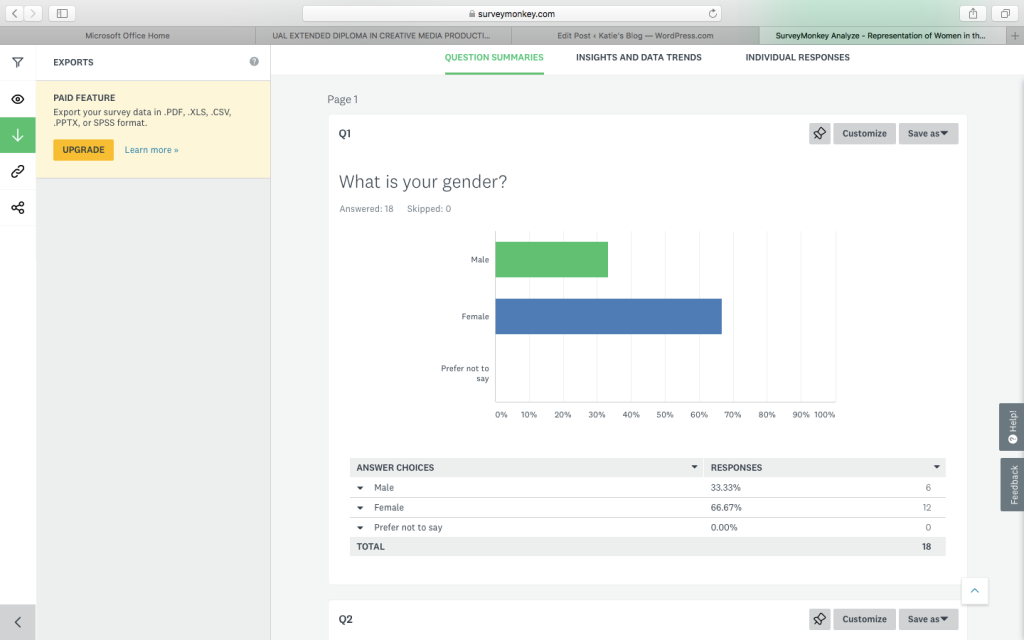
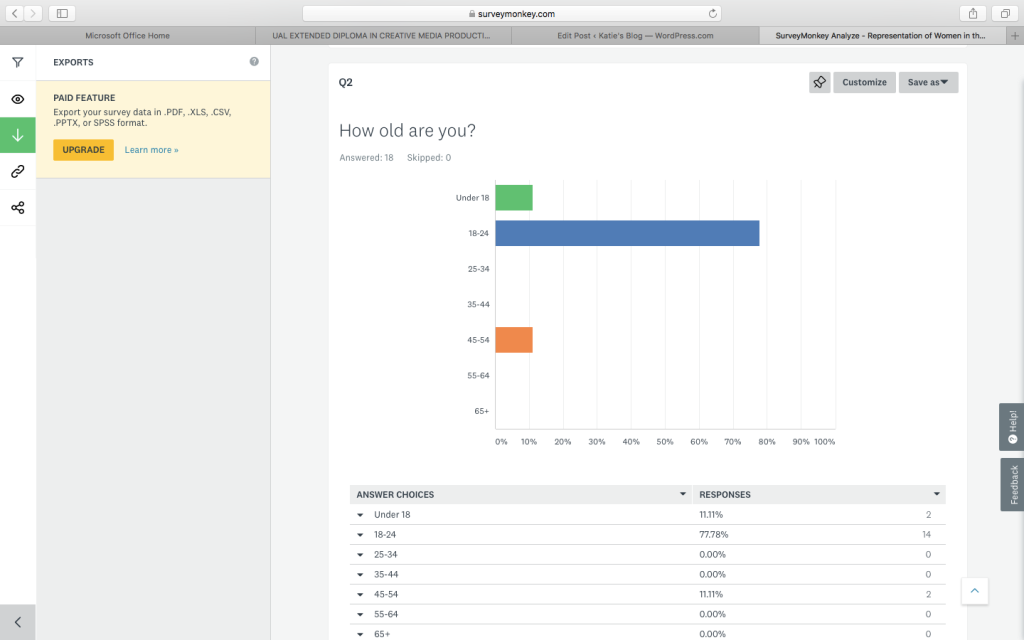
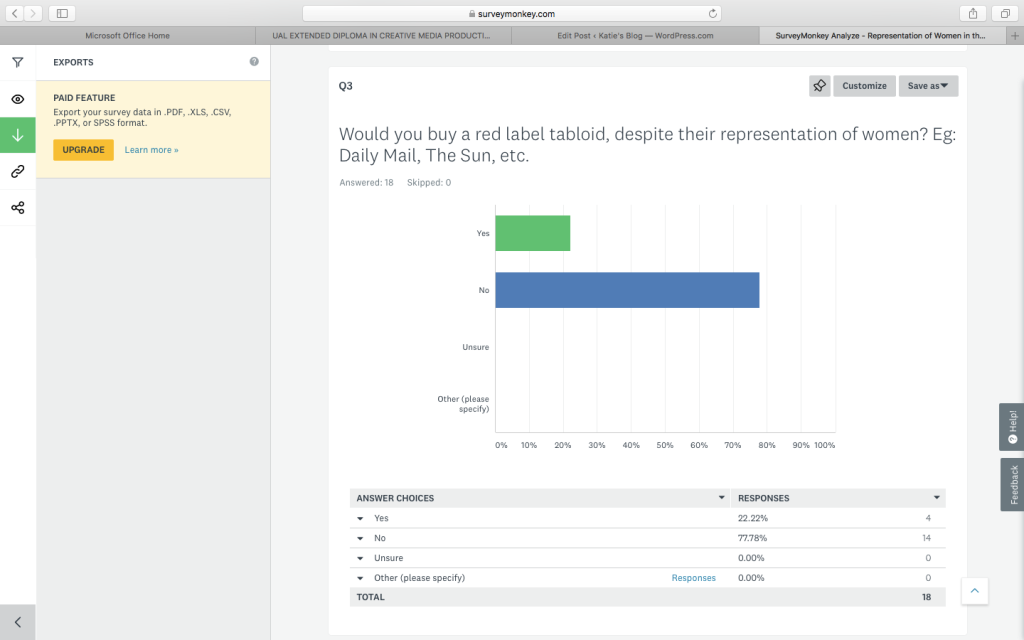

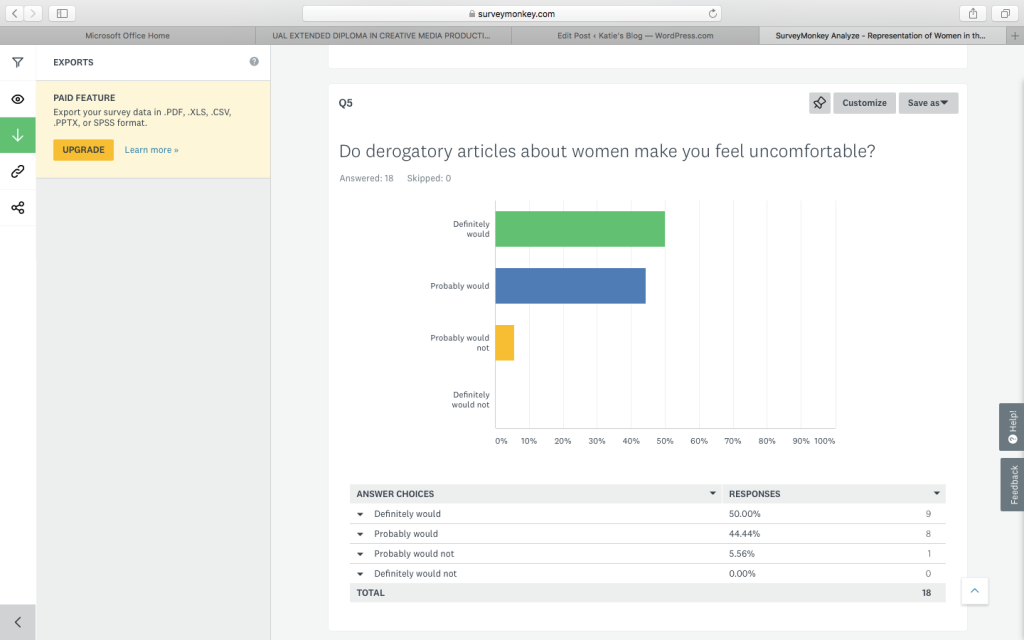
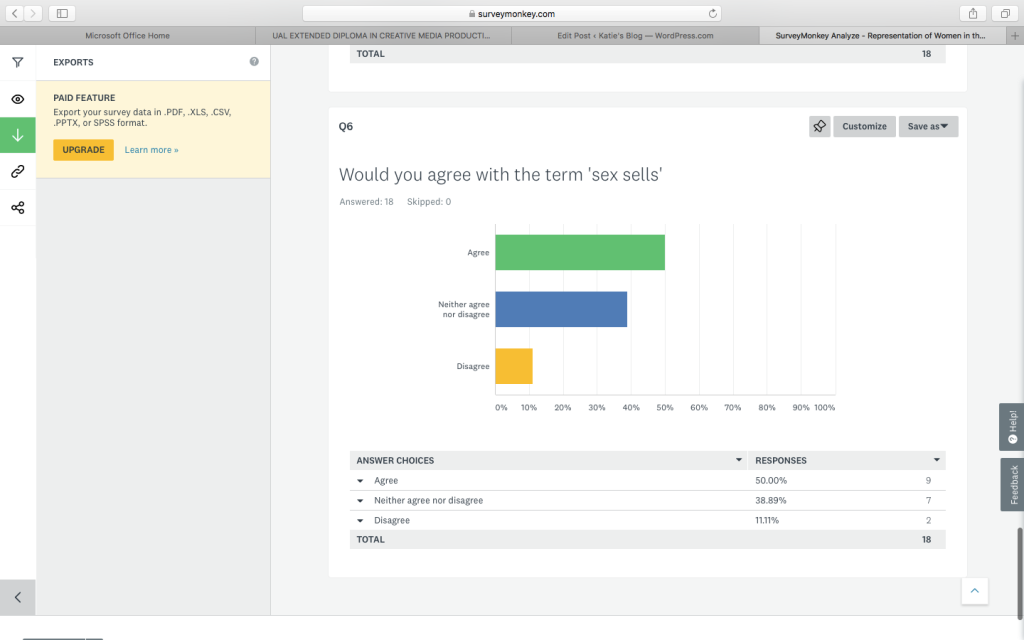
Secondary Research:
Initial research before I put it all in a log and annotated catalogue.
Male Gaze Theory:
- Mulvey’s 1974 theory – influenced by Freud and Lacan.
- www.filminquiry.com/film-theory-basics-laura-mulvey-male-gaze-theory/ (online blog/article)
- www.psychologytoday.com/us/blog/the-clarity/201711/taking-back-the-male-gaze (online article)
- Women don’t owe you pretty – Florence Given – chapter 14, Women don’t exist to satisfy the male gaze (book)
- https://youtu.be/vw-ps5mFQzA – In conversation with Laura Mulvey. (Youtube Interview)
- https://youtu.be/o82gms9HAh8 – Frances Goodman: Spit or Swallow, questioning the way in which we adhere to the male gaze. (Youtube Interview)
- https://youtu.be/pU5d6erHV9w – Adèle Haenel – The Male Gaze. (Youtube Interview)
Sex Sells Concept:
- www.businessnewsdaily.com/2649-sex-sells-more.html (article)
- PDF: Sex Sells? The role of female agency in sexualised advertisements. (Pages 3, 4, 28 and 29)
- www.honeycopy.com/copywritingblog/sex-sells – An in-depth look at sex in advertising. (Blog Post)
- www.theschooloflife.com/thebookoflife/on-using-sex-to-sell/ – Theorist piece on the sex sells concept.(Article)
- https://en.wikipedia.org/wiki/Sex_in_advertising (Wiki Page)
- Sex Sells: The feminine mystique in the 19th century Spain. (Article/Book) (VQR Online)
- https://www.youtube.com/watch?v=EU8QGK6pn5U&t=293s – Sex sells, but should it? (Youtube Vid, small documentary)
- https://www.youtube.com/watch?v=oWqKvXzV46A – Does sex really sell? (Youtube Video)
History of the representation of women:
- https://www.bbc.co.uk/bitesize/guides/zq6qsg8/revision/1 – GCSE representation of gender (website)
- https://revisesociology.com/2019/09/02/media-representations-women/ – (Article)
- https://studybreaks.com/culture/women-representation-media/ (Article)
- https://davidgauntlett.com/portfolio/media-gender-and-identity/ – Media, Gender and Identity – David Gauntlett. (Book)
- https://www.youtube.com/watch?v=VcpBFFClymY _ Holly Baxter on What’s wrong with women in the media. (Ted Talk)
History of the Tabloid:
- https://wordhistories.net/2017/03/02/red-top/ (Blog Post)
- https://www.historic-newspapers.co.uk/blog/tabloid-history/ (Blog/Article)
- http://www.woe.edu.pl/content/art-bad-taste-british-tabloid (Article)
- https://www.google.co.uk/books/edition/Family_Newspapers_/kswSDAAAQBAJ?hl=en&gbpv=0 – Family Newspapers? Sex, Private Life and the British Popular Press 1918-1978. – Adrian Bingham. (Book)
Annotated Catalogue:
An exploration into the sexualisation of women in the British Tabloid newspapers with references to The Sun.
Books:
Item 1:
Given, F. (2020) Women Don’t Owe You Pretty. London: Cassell. (Chapter 14)
This book sheds light on the feminist perspective of the male gaze, and the way in which women are socially brought up to conform and please the male gaze. It has an interesting view on the push back of the male gaze, and how women should be aware of the subconscious behaviours we have relative to the male gaze. This was relevant to my essay as it gave a good part of information on the subject of the male gaze from an independent angle. This source is particularly trustworthy as it is well trusted and respected author and published book.
Item 2:
Gauntlett, D. (2002) Media, Gender and Identity: An Introduction. London: Routledge.
This book presents an angle of the modern relations between the media, people’s gender and the identity they are presented with. It also covers the topic of the way in which we can be impacted by our identities and how this can prove to be an issue for people day to day. It’s a modern, fresh view on the topic, and provides with a clear and easy to understand script. This is relevant to my essay as it provides an outlook on the way in which media can affect and obscure people’s identities and they way in which they are viewed by themselves and others. This source is reliable and trustworthy as it is a well regarded book, however should be careful in terms of opinions.
Item 3:
Bingham, A. (2009) Family Newspapers? Sex, Private Life and the British Popular Press 1918-1978.. Oxford: Oxford University.
This book analyses the detail and scandal within the media and the press in a space of 60 years, covering the way in which people’s lives were talked on and judged by the press, therefore giving a false representation to the public at the time, unbeknown to those that were spoken of. The book also covers the way in which the media would still try to keep the stories ‘family friendly’ as they were still deemed ‘family friendly newspapers’ at the time. This book proved relevant to my search as it gives an angle on representation in the media through the years, and the way sex and women were spoken about even in a, what was deemed ‘family friendly’, newspaper. This is well trusted source because it is a research based book and contains sources and not too much opinion.
Websites:
Item 4:
Sampson, R. (2015) Film Theory 101 – Laura Mulvey: The Male Gaze Theory. Available at: https://www.filminquiry.com/film-theory-basics-laura-mulvey-male-gaze-theory/ (Accessed: 9 February 2021).
I found this source to be particularly useful and informative as it is a modern, feminist take on the issue. Sampson touched on the male gaze theory in both media, film and advertising, giving a broad range of angles and takes on the male gaze theory in modern day life and things we see and subconsciously take in everyday. It also allowed me to understand the male gaze from a similar perspective to mine, and associate it with the subject of my essay. I think this article is trustworthy as it is a research and theory fuelled article, however again have to be careful where opinion comes into it.
Item 5:
Well, T. (2017) Taking Back The Male Gaze. Available at: https://www.psychologytoday.com/us/blog/the-clarity/201711/taking-back-the-male-gaze (Accessed: 9 February 2021).
Similarly to a previous source, I found this one particularly useful and interesting. This article strips back the theory of the male gaze and applies it to modern life and the way in which it is used for and against us in different ways. The article also speaks on how women should use the male gaze to their advantage and how they can use the theory to make themselves feel more confident and independent. I think that this article is relatively trustworthy as it contains multiple research methods and sources, however, also contains lots of opinion and theory.
Item 6:
Author Unknown (2020) Why Sex Sells More Than Ever. Available at: https://www.businessnewsdaily.com/2649-sex-sells-more.html (Accessed: 9 February 2021).
This article is more so talking about advertising but it still covers the sex sells concept in media and the portrayal of women in the media, ie tabloids. However, I found the description and reasoning behind the concept in this article really useful for understanding the base of the concept ‘sex sells’. This is relevant to my research as in my essay I will be writing on the topic of sex sells and the way in which women are portrayed in that type of media, so reading up on the way sex sells was relevant for this. Following that, I think this article was interesting and useful. I also think this article is trustworthy as it contains lots of statistics and research, and comes from a website that is well regarded.
Item 7:
Thompson, K. (2019) Media Representations of Women. Available at: https://revisesociology.com/2019/09/02/media-representations-women/ (Accessed: 9 February 2021).
This article focuses on the underselling and misrepresentation of women in the media throughout the years. This article was one of the most useful and information packed sources I’ve used. The article speaks on the historical links and links to gender stereotypes and how that impacts on the way in which women are presented and spoken of in the media. This is relevant to my essay as it is about the way in which women are sexualised in the media, and the impacts this has. I believe this article is a reliable source as it contains research and theories and a lot of in depth information.
Item 8:
Emilaire, S. (2017) A Look at Women Represented in the Media. Available at: https://studybreaks.com/culture/women-representation-media/ (Accessed: 9 February 2021).
Similarly to the previous source, this blog post was based on the history of female roles in society and the way in which women have certain roles in the media. This article is more like a blog post, so I feel as if it wouldn’t be as reliable and trustworthy, but the source does have a lot of information that will be really useful and relevant for my essay.
Item 9:
Davies, H. (2002) The Art of Bad Taste: The British Tabloid. Available at: http://www.woe.edu.pl/content/art-bad-taste-british-tabloid (Accessed: 9 February 2021).
This source focuses on the controversy of tabloids and the type of articles they produce. It is more of a blog post than an article, so does include opinion as well as facts, therefore meaning this source could be one of the less reliable sources. However, I found this blog post very interesting and provided an individual angle on tabloids, and focuses on the ‘bad taste’ that tabloids provides in the media. This is relevant to my essay as I am writing an essay based on the representation in tabloids, so to see this angle on tabloids is very relevant.
Videos and Interviews:
Item 10:
Greatest Ever (2020) Adèle Haenel – The Male Gaze. Available at: https://www.youtube.com/watch?v=pU5d6erHV9w (Accessed: 9 February 2021).
I found this interview so interesting as the actress explained to the interviewer the way in which the male gaze is used ad dismissed daily, also correcting him and educating him in a way without being patronising, it also allowed me to learn more about the topic through listening to what she had to say. The interview is based on the film she featured in, and how they steered away from using the male gaze in their film. This interview was relevant to my essay as I will be speaking on the male gaze concept throughout my essay. I believe this is a trustworthy source despite it being opinion, I feel as though it is a well respected interview.
Item 11:
TEDx Talks (2014) Everything That’s Wrong with Women in the Media. Available at: https://www.youtube.com/watch?v=VcpBFFClymY (Accessed: 9 February 2021).
This Ted Talk is from a lady who talks about the representation and way in which women are written about in the media. She talks about what she thinks, and the way in which the media has affected her, and also her personal experiences with the male gaze and the misinterpretation and representation of women in modern day. I found this source very intriguing and quite eye opening to how she applies it to her personal life. I think this is relevant to my essay as it contains personal experience and researched headlines and stories. I think this source is well trusted as it is a well regarded source – Ted Talks, and the lady is well regarded in terms of feminism and media.
Item 12:
Racked (2017) Does Sex Really Sell?. Available at: https://www.youtube.com/watch?v=oWqKvXzV46A (Accessed: 9 February 2021).
This source is from a channel that researches different things, and in this instance they researched the theory and concept of ‘does sex sell’, this video gives a short insight to the way in which sex sells and the male gaze contributes to the way we sell things nowadays. For example in magazines, media, tv etc. I think this is a good and reliable source as it is well researched by a well respected channel.
Websites and Theory Articles:
Item 13:
Schafer, C. (2018) Does sex sell? An in-depth look at sex in advertising.. Available at: https://www.honeycopy.com/copywritingblog/sex-sells (Accessed: 9 February 2021).
This source is one of the less reliable sources, as it is a blog post and based on the one opinion of the blog writer, however it does pose some good points and have some information than I can pass into my essay. Following that, it is slightly off as it is based on advertising rather than the media and portrayal, but I still think it contributes to my research as it speaks on the topic of sex sells nd the way that its used.
Item 14:
Not available (2020) Sex in Advertising. Available at: https://en.wikipedia.org/wiki/Sex_in_advertising (Accessed: 9 February 2021).
I found this source to be interesting as it provided a lot of information on the topic, however again it is related to advertising rather than the media. It has all the aspects ranging from history to effectiveness to criticism. It’s good for facts and small parts of information, however I feel as though its not the best source I have out of the ones I’ve used. I think this is probably the least reliable source as Wikipedia is accessible for anyone to edit, so you can’t ever be sure of the legitimacy.
Item 15:
Tréguer, P. (2017) ORIGIN OF THE BRITISH JOURNALISTIC TERM ‘RED TOP’. Available at: https://wordhistories.net/2017/03/02/red-top/ (Accessed: 9 February 2021).
This source is a blog post on the origin and history of the red top tabloids. This is relevant to my essay as my main focus is the representation of women in ‘redtop’ tabloids. So, finding this blog allowed me to expand my knowledge of the history of tabloids, and how they have evolved through the years. Following that, the blog explores the difference between tabloid and broadsheet and the clear distinction between the two. I think this source is relatively reliable as there are multiple statistics and facts throughout, and doesn’t involve too much opinion.
TWO SOURCES I DIDN’T INCLUDE:
Item 1:
Keller, M. , Walker, M. and Reutner, L. (2019) (PDF) Sex Sells? The Role of Female agency in Sexualised Advertisements. 1st edn. Basel: N/A.
I didn’t include this as a source as I found it to be too heavy, although it did provide lots of information, I feel as though it wasn’t the best source in terms of my essay. It also focused too much on advertising rather than the broad spectrum of the concept in media.
Item 2:
Louisiana Channel (2020) Frances Goodman Interview: Spit or Swallow. Available at: https://www.youtube.com/watch?v=o82gms9HAh8&t=474s (Accessed: 9 February 2021).
Despite this source being about the male gaze, and the way in which women adhere to the male gaze. Frances Goodman a feminist activist talks about her project and the way she hopes to encourage women to be independent. She speaks on the issue and the topic briefly and this is why I didn’t include the source, as I feel as if the topic isn’t covered in too much detail and that she speaks more on her project.
Part Four – Essay:
Rough Plan:
- Introduction
- The effects of sexualisation
- The reaction – survey etc
- Sex sells concept
- Male gaze theory
- Tabloids
- The Daily Mail
- Conclusion
Draft Essay: 1500 words give or take 10% –
Peer Feedback sheet for the First Draft:
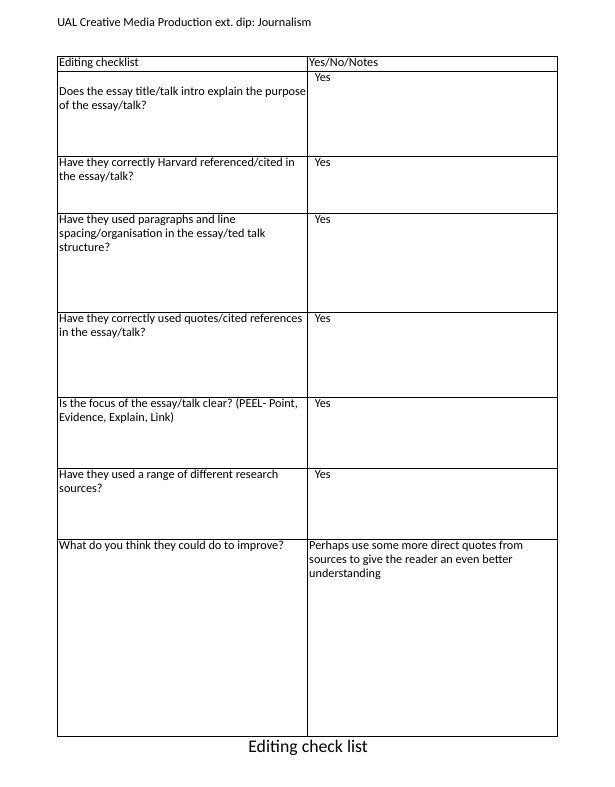
Final draft including Bibliography and Adjustments:
